 Kia Optima: Windshield Glass. Repair procedures
Kia Optima: Windshield Glass. Repair procedures
Replacement
Removal
| Х |
Put on gloves to protect
your hands. |
| Х |
Use seat covers to avoid
damaging any surfaces. |
|
| 1. |
Remove the following items.
| A. |
Front pillar trim (Refer
to the BD group - "Interior Trim")
|
| B. |
ECM mirror (Refer to
the BD group - "Mirror")
|
| C. |
Rain sensor (Refer
to the BE group - "Rain Sensor")
|
| D. |
Windshield wiper arm
(Refer to the BD group - "Cowl Top Cover")
|
| E. |
Cowl top cover (Refer
to the BD group - "Cowl Top Cover")
|
| F. |
Windshield glass deicer
connector (Refer to the BE group - "Windshield Wiper")
|
|
| 2. |
Using a screwdriver or remover,
remove the windshield side molding (A).
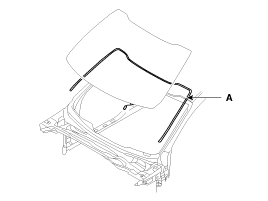
|
| 3. |
Cut out the windshield sealant
using the sealant cutting tool (09861-31100).
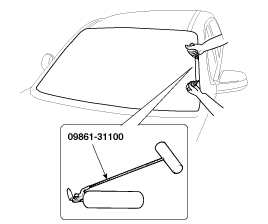
| Х
|
Do not scrape
down to the painted surface of the body; damaged paint will
interfere with proper bonding. |
| Х
|
Remove the rubber
dam and fastereners from the body. |
| Х
|
Mask off surrounding
surfaces before painting. |
|
|
| 4. |
Remove the windshield glass (B)
carefully using the glass holder (A).
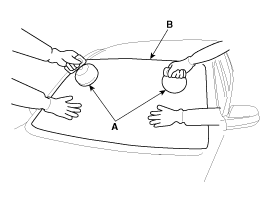
|
Installtion
| 1. |
With a knife, scrape the old
adhesive smooth to a thickness of about 2mm (0.08 in.) on the bonding surface
around the entire windshield opening flange:
| A. |
Do not scrape down to
the painted surface of the body; damaged paint will interfere with
proper bonding. |
| B. |
Remove the rubber dam
and fastereners from the body. |
| C. |
Mask off surrounding
surfaces before painting. |
|
| 2. |
Clean the bonding surface with
a sponge dampened in alcohol. After cleaning, keep oil, grease and water
from getting on the clean surface. |
| 3. |
Install the windshield side molding
(A) and fasteners. Do not allow any gaps.

|
| 4. |
Install the spacer (A) install
the windshield glass (B) temporarily with marking sure to position them
on the center, and then place the alignment mark (C).
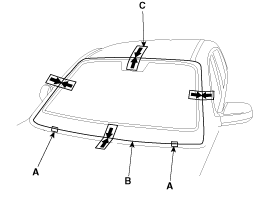
|
| 5. |
With a sponge, apply a light
coat of body primer to the original adhesive remaining around the windshield
opening flange. Let the body primer dry for at least 10 minutes.
| A. |
Do not apply glass primer
to the body, and be careful not to mix up glass and body primer
sponges. |
| B. |
Never touch the primed
surfaces with your hands. |
| C. |
Mask off the dashboard
before painting the flange. |
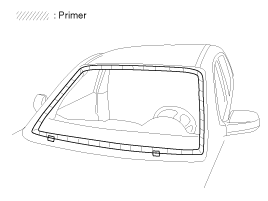
|
| 6. |
Apply a light coat of glass primer
to the outside of the fasteners.
| Х
|
Never touch the
primed surface with your hand. If you do, the adhesive may
not bond to the glass properly, causing a leak after the
windshield glass is installed. |
| Х
|
Do not apply
body primer to the glass. |
| Х
|
Keep water, dust,
and abrasive materials away from the primer. |
|
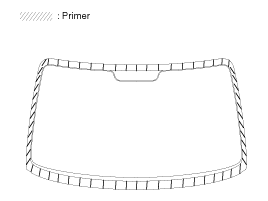
|
| 7. |
Pack adhesive into the cartridge
without air pockets to ensure continuous delivery. Put the cartridge in
a caulking gun, and run a bead of adhesive (B) around the edge of the windshield
glass (A) between the fastener and molding as shown. Apply the adhesive
within 30 minutes after applying the glass primer. Make a slightly thicker
bead at each corner.
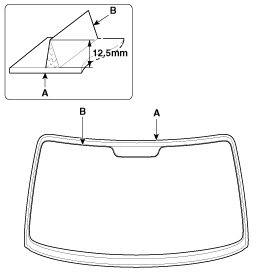
|
| 8. |
Use suction cups (A) to hold
the windshield glass (B) over the opening, align it with the alignment marks
(C) made in step 15, and set it down on the adhesive. Lightly push on the
windshield until its edges are fully seated on the adhesive all the way
around. Do not open or close the doors until the adhesive is dry.
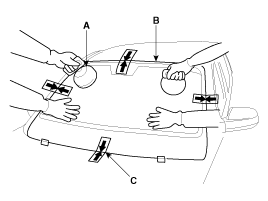
|
| 9. |
Scrape or wipe the excess adhesive
off with a putty knife or towel. To remove adhesive from a painted surface
or the windshield, wipe with a soft shop towel dampened with alcohol. |
| 10. |
Let the adhesive dry for at least
one hour, then spray water over the roof and check for leaks. If a leak
occurs, let it dry, then seal with sealant :
| A. |
Let the vehicle stand
for at least four hours after windshield installation. If the vehicle
must be driven within 4 hours, it must be driven slowly. |
| B. |
Keep the windshield dry
for the first hour after installation. |
|
| 11. |
Installation the following items.
| A. |
Windshield glass deicer
connector (Refer to the BE group - "Windshield Wiper")
|
| B. |
Cowl top cover (Refer
to the BD group - "Cowl Top Cover")
|
| C. |
Windshield wiper arm
(Refer to the BD group - "Cowl Top Cover")
|
| D. |
Rain sensor (Refer
to the BE group - "Rain sensor")
|
| E. |
ECM mirror (Refer to
the BD group - "Mirror")
|
| F. |
Front pillar trim (Refer
to the BD group - "Interior Trim")
|
|
Components
1. Windshield side molding
2. Windshield glass
...
Components
1. Rear window glass molding
2. Rear window glass
...
 Kia Optima: Windshield Glass. Repair procedures
Kia Optima: Windshield Glass. Repair procedures Windshield Glass. Components and Components Location
Windshield Glass. Components and Components Location Rear Window Glass. Components and Components Location
Rear Window Glass. Components and Components Location







